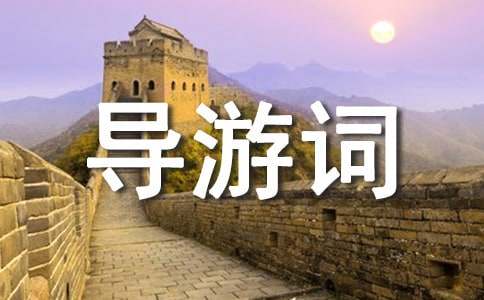作为一名尽职尽责的导游,可能需要进行导游词编写工作,导游词是导游员进行实地口语导游的基础和前提。那么写导游词需要注意哪些问题呢?下面是小编为大家整理的英文导游词范文,仅供参考,欢迎大家阅读。

英文导游词范文1
HANGZHOU---The Heaven on Earth --------By Day Day The Great “It’s the most wonderful place in the world, where makes you feel in the heaven”, the famous Italy traveler Macro Polo describes the HangZhou in his memory. The saying goes that in China---Above is heaven, below is HangZhou. The reputation of HangZhou lies in the picturesque West Lake. The lake is beautiful all year round, and the poet in Song dynasty named DongPo Su highly praised the scenery. Travelling in the West Lake, you can also wander along the street, try the delicious dessert, and purchase some local products. The Su dam and White dam are of the most famous scenic spots in China. They divided the lake into halves, seemed like two fluttering green ribbons, surrounded by mountain and forests with some house lets. There are there islands in the center of the lake: RuanGong, HuXin, and YingZhou. HangZhou is one of the six ancient capitals in China, and it last 2,000 years history. Not only famous for the Natural scenery and Cultural charm, but also for its delicacy, crafts, and calligraphy of historical figures. As the Silk City of China, there are all kinds of silk products;tapestry is the especially beautiful one among them. Other specialties are black-paper-fans, silk umbrella, and West Lake Longjing Tea. Generally, the appropriate time for going sightseeing near the West Lake in HangZhou should be two days, and the travel provides you with cheerful mood and cultural enjoyment.
英文导游词范文2
Tibet lies on the Qinghai-Tibet Plateau of the southwest border of China. The average height of the whole region is more than 4,000 meters above sea level, for which Tibet is known as "Roof of the World". The highest peak of Tibet, also the highest in Himalayas and in the whole world, is Everest Peak, which is as high as 8,846.27 meters above sea level.
Although a part of China, Tibet has a unique culture of all there own. It is mainly inhabited by Tibetans, a minority nationality of old and mysterious people. Tourist attractions include the Potala Palace in Lhasa, Jokhang Temple, and a number of Buddhist sacred places.
Tibet (Xi Zang in Chinese) is to the south of Xin Jiang Uygur Autonomous Region and Qing Hai Province, to the west of Sichuan, to the northwest of Yunnan and to the north of India and Nepal. Its population of 2.3 million people come from a variety of ethnic groups including Tibetan, Han, Monba and Lhota. Its capital city is Lhasa.
Northwest Tibet, mainly Qing Hai plateau, is home to a variety of unusual and unique animals. Across the northern expanse of Tibet, you can see vast grasslands where horses, yak and sheep roam freely. The world’s lowest valley, the Grand Yarlun-tzanpo River Valley lies in east Tibet.
Nearly all Tibetans follow Tibetan Buddhism, known as Lamaism, with the exception of approximately 2,000 followers of Islam and 600 of Catholicism. Tibetan Buddhism was greatly influenced by Indian Buddhism in its early time, but after years of evolution, Tibetan Buddhism has developed its own distinctive qualities and practices. A well-known example is the belief that there is a Living Buddha, who is the reincarnation of the first, a belief alien to Chinese Buddhism.
It is freezing cold in most time of the year. Most tourists come to visit Tibet only in the warmest seasons, June, July, August and early September.